

Coaching organisation avec Bernadette Lecerf-Thomas - La mémoire du futur. Avoir des cartes mentales pour explorer le territoire Conduire un projet de changement nécessite l’élaboration d’une vision.
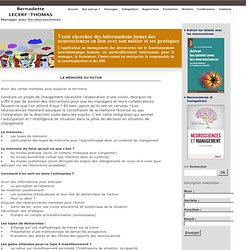
Pourquoi ne suffit-il pas de donner des instructions pour que les managers et leurs collaborateurs fassent ce que l’on attend d’eux ? Eh bien, parce qu’ils ont un cerveau ! Les neurosciences montrent pourquoi la constitution de la mémoire favorise ou pas l’intégration de la direction visée dans les esprits. C’est cette intégration qui permet l’anticipation et l’intelligence de situation dans la prise de décision en situation de changement. La mémoire : • Les types de mémoire • L’articulation des types de mémoire pour l’apprentissage dans un contexte de changement La mémoire du futur qu’est-ce que c’est ? Three (Incredibly Simple) Questions The Most Successful People Use To Change The World. 3-Visualizations & mapping. Mind Mapping Software, Brainstorming, GTD and Knowledgebase Software.
Methods. How to run a Knowledge Café by David Gurteen. That helps you to set up and run your own cafés. .
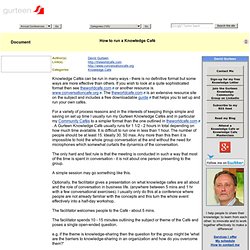
A Gurteen Knowledge Café usually runs for 1 1/2 - 2 hours in total depending on how much time available. It is difficult to run one in less than 1 hour. The number of people should be at least 15. Ideally 30. 50 max. The only hard and fast rule is that the meeting is conducted in such a way that most of the time is spent in conversation - it is not about one person presenting to the group. A simple session may go something like this. Optionally, the facilitator gives a presentation on what knowledge cafes are all about and the role of conversation in business life. The facilitator welcomes people to the Café - about 5 mins. HDL Blog - Helsinki Design Lab. The Museum of the Future » 30 do’s for designing successful participatory and crowdsourcing projects. This week at the Dish conference in Rotterdam I gave a presentation about all the do’s and don’ts, tips and tricks, lessons and hands-on advice about crowdsourcing from my experience at the Museum of National History.

Well… that’s quite a lot to talk about. All in all I came up with some 25-30 little notes, which the audience of my presentation – in a little participatory trick – had to label as do’s or don’ts. Here’s the full list, now all as do’s, with some additional ideas that didn’t fit in the presentation. Use it to your benefit and please add your thoughts when you feel I’ve missed some. Ask your potential participants a clear question or a clear task. These 30 things might not all be applicable to your future project, and probably there’re countless examples of projects done differently that were successful anyway. What have I missed? Photo by Chris Blakely on Flickr. inShare3 about the author: Jasper Visser. Futuring: The Exploration of the Future.
Futuring: The Exploration of the Future by Edward Cornish.
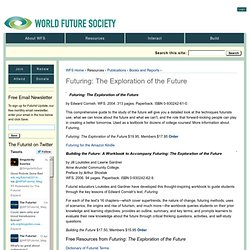
WFS. 2004. 313 pages. Paperback. ISBN 0-930242-61-0. This comprehensive guide to the study of the future will give you a detailed look at the techniques futurists use, what we can know about the future and what we can't, and the role that forward-looking people can play in creating a better tomorrow. Futuring: The Exploration of the Future $19.95, Members $17.95 Order Futuring for the Amazon Kindle. Dictionary of Foresight. 3 Tools for Futures Thinking & Foresight Development.
(followup to When Futures Thinking Meets Design Thinking post) The last post outlined a general framework for “futures thinking.”
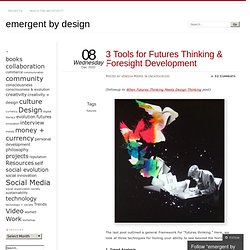
Here, we look at three techniques for honing your ability to see beyond the horizon. 1. Trend Analysis In order to develop the capacity for imagining alternative futures and create design solutions accordingly, it is useful to be aware of the current driving forces and megatrends underway. Once a trend is identified, both its causes and impacts can be considered. Another example is the increasing amount of “leisure time” people are now facing. 2.
Clarifying a vision is one of the most powerful mechanisms for engaging a team, organization or community and getting them excited to push forward into new territory. How To Change the Future. 2nd Oct 2012; 18:00 Listen to the audio (full recording including audience Q&A) Please right-click link and choose "Save Link As...
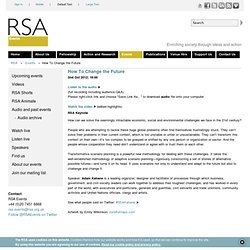
" to download audio file onto your computer. Watch the video (edited highlights) RSA Keynote How can we solve the seemingly intractable economic, social and environmental challenges we face in the 21st century? People who are attempting to tackle these huge global problems often find themselves frustratingly stuck. Transformative scenario planning is a powerful new methodology for dealing with these challenges. Speaker: Adam Kahane is a leading organizer, designer and facilitator of processes through which business, government, and civil society leaders can work together to address their toughest challenges, and has worked in every part of the world, with executives and politicians, generals and guerrillas, civil servants and trade unionists, community activists and United Nations officials, clergy and artists.